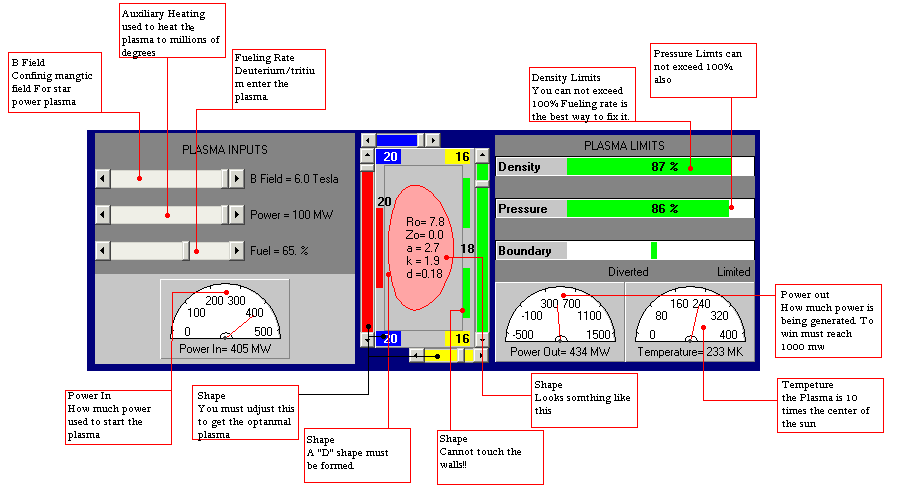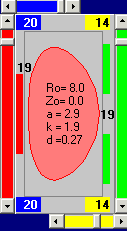
It is the year 2020 and you will be starting up the State-of-the-Art Reactor (STAR2020)
 It is the year 2020 and you will be starting up the State-of-the-Art Reactor (STAR2020) |

Our fusion power plant (STAR2020) has many of the same attributes
of a more conventional fossil fuel or nuclear power plant. However, unlike conventional
power plants, a confining magnetic field (B-field) is needed in the chamber to
prevent the extremely hot fuel from contacting the chamber wall. Essentially,
the magnetic field acts like the pressure vessel to contain the plasma. Stronger
magnetic fields produce better magnetic bottles and increase the power output
potential of the reactor. You can control this confining field using a slider
on the power supply to actuating this magnetic field. Large values are best for
performance in STAR2020.Uses a toroidal magnetic bottle typically referred to
as a Tokamak. The general shape of the magnetic bottle is that of a torus.
Deuterium/Tritium
(D/T) is the fuel source which is injected into the plasma chamber. A 50/50
mixture of D/T
is heated to form an ignited plasma. Energy from an auxiliary power source is
needed to bring the fusion fuel to the 100's of millions of degrees needed for
the fusion reaction to occur in STAR2020 (note that this is more than 10 times
the temperature of the center of the sun). Once the fuel is hot enough, the nuclear
reactions produce sufficient heat to maintain the temperature (a condition referred
to as ignition) and the auxiliary heating can be turned off.
The use of a magnetic bottle to confine the plasma allows
modification of the outer shape of the boundary. A second set of magnets is provided
to allow shaping of the small cross section of the plasma. These magnets are
located directly outside the plasma chamber and, when energized, are capable
of modifying the plasma shape from its natural circular configuration. The shape
magnets, when energized, pull on the plasma. Vertically elongated cross sections
which have the shape of the letter D work best in generating power in STAR2020.
These magnets also keep the plasma away from the wall and allow formation of
what is referred to as diverted plasma. You can experiment with different plasma
shapes to enhance the performance of STAR2020. There are natural plasma limits
just like there are limits in other types of power plants.
In STAR2020, the main limits are associated with pressure
(referred to as the beta limits) and density. Essentially, with a given magnetic
field and plasma shape, you can only confine a certain pressure and number of
particles in the magnetic bottle before it becomes very leaky. The main control
for both these limits is the fueling rate; although all control parameters influence
these limits.
CONTROLS/DIAGNOSTICS
You will have two general sets of controls for STAR2020:
(I) Shape Control Magnets and (II) Plasma Control.
In addition, you have a set of Diagnostics which you can
monitor to determine the performance of STAR2020. You must
adjust the controls while monitoring the plant diagnostics
to optimize the electrical power output of STAR2020.
(I) SHAPE CONTROL MAGNET
In the STAR2020 tokamak, there are four (4) magnet controls which can be used
to change the cross sectional shape of the plasma. Each magnet attracts the
plasma. Increasing the magnitude of the magnet field will cause the plasma
to move closer to the magnet. The best performing plasma is one that has
(1) the largest cross sectional area, (2) has an elliptical or "D"-shaped
cross section, and (3) does not touch the rectangular vacuum chamber wall. This
is
referred to as a diverted "D"-shaped plasma and experimental results
show this
shape performs best in tokamak devices.

(II) PLASMA CONTROL
There are three major plasma controls: (1) Confining Magnetic Field, (2) Auxiliary Heating, and (3) Fueling. Confining
Magnetic Field:
Confining Magnetic Field is the major field which confines the plasma inside
the chamber. It is directed in the toroidal direction which is in the long direction
of the torus.
Charged particles [+ (ions) and - (electrons)] rotate around these field lines
and are essentially trapped on the field lines. The STAR2020 is capable of producing
6 Tesla of
toroidal field. Hint: You want to maximize this field.
[Slider range: 0-6 Tesla]
Auxiliary Heating: Auxiliary heating is used to heat the plasma from ambient
temperature to the 100s of millions of degrees needed for the fusion process.
STAR2020 has the capability of
injecting up to 100 MW of power into the plasma. However, this takes considerable
electric power (of order 300 MW) and, accordingly, this device should be switched
off once the plasma fusion process is sustaining or ignited. This occurs when
substantial
fusion energy is produced.
[Slider Range: 1-100 MW]
![]()
Fueling Rate:
Fueling Rate is the rate at which the Deuterium/
Tritium fuel is injected into the plasma. A 50/50 mixture of D/T has the highest
reaction rate and is used in STAR2020. As with all chemical and nuclear processes,
fuel is continually needed in order to sustain the reaction. In STAR2020, some of
the injected fuel is consumed in the fusion process to form helium and is
considered an ash in our reactor. The particle density (and accordingly the pressure)
is very sensitive to this control parameter and this is the best control to insure
the density and pressure remain below limits.
[Range: 0-20]
![]()
(II) DIAGNOSTIC GAGES There are several fusion power plant monitoring instruments such as input electrical power and pressure as well as density limits. Use these to monitor the plants performance. Plasma Operational Limit: The plasma has pressure and density limits which cannot be exceeded. Once the pressure or density is within 90% of the operational limit, the limit bars turn yellow. At 100% of the limit, the bars will turn red and an alarm will sound. Operating STAR2020 above this limit is not recommended. Although all controls have some impact on these limits, the best tool to control both limits is the fueling rate. In particular, a large confinement field is needed to insure the pressure limit is not exceeded.

Power Meters: STAR2020 has two power meters. One monitors the electricity coming in from the electrical grid. The second meter monitors the net electricity the plant produces (gross electrical less input electrical). This is the electricity needed by the city and your task is to produce more than 1000 MW; however, STAR2020 can exceed this output. Try and determine the maximum value you can produce while keeping within the plasma


operational limits. This is the main
meter you need to watch as you optimize the plant parameters. Plasma Temperature:
Temperatures greater than 10 times the temperature of the center of
the sun (~16 million degrees) is needed in STAR2020's fusion reaction.
Optimal temperatures for STAR2020 range from 100 to 300 million degrees.
![]()
Boundary. The plasma Boundary can
scrape off on the vacuum vessel wall, called Limited, or it can be completely
contained
within the magnetic
field, called Diverted. The latter "Diverted" configuration is optimal
and is needed to obtain reasonable performance. This state is obtained by
elongating the plasma cross section into an elliptical shape with the magnets
and maintaining a small gap from the vessel walls. The gap distance is shown
in
the Boundary bar shown below. The position of the mark indicates plasma/wall
gap. A red mark indicates it is almost fully limited and touching the wall. A
green mark indicates it is diverted with little impact with the wall. Peak
performance can only be achieved with the plasma Diverted (green) or partially
diverted (yellow).
![]()
![]()
![]()
Step By Step Proceedeure
Step 1: Increase the Magnetic Field Strength
(B-field) to its highest value.
Step 2: Using the four magnet controls (slider bars) around the plasma chamber,
produce a plasma shape which:
(1) has a large cross sectional area,
(2) looks D-shaped, & (3) doesn't touch the chamber walls.
Step 3: Increase the auxiliary heating (Power) and D/T fueling (Fuel) to
some moderate values close to their maximum without exceeding plasma Density
and Pressure limits (100%).
Step 3: Once the plasma is hot (ignited) and you are producing moderate electrical
energy, reduce the auxiliary heating to zero.
Step 4: Modify all controls until you maximize the electric Power Output.
You should be able to achieve 1000MW Caution: The plasma has intrinsic limits
(pressure and density) which you must stay below.
When you are within 90% of a limit the bars turn yellow. At 100% of the limit,
an alarm sounds and the limit turns red. Reduce the fueling rate until the reactor
is within safe limits. For
all of you have read this far I congratulate you and offer you the magic cheat
sheet for stating 2020. To see cheat sheet click here.
Thank you for your time good luck.
Please reports bugs to: leuer@fusion.gat.com